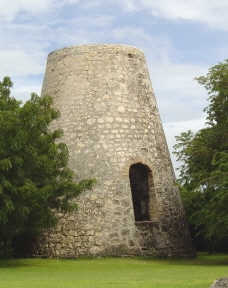About
Type: Extant
Parish: St. Peter
Founding date: 1750
See on Google Maps!

Current Status:
Ownership for both Upper and Lower Cedar Hill remained the same until recently when both buff houses were purchased privately and rebuilt on the original structure. It was owned by the Byam family for over 200 years.
There is still a mill at lower Cedar Hill which is in excellent shape. At one time the mill was turned into a small apartment where Ian Fraser and his wife resided until it unfortunately caught fire partially destroying the apartment in 2000. At the entrance to this property old sugar mill machinery has been placed on either side of the gate as the driveway winds gently up to the front door.
Estate Related History/Timeline
Cedar Hill Lower became a working plantation in 1688. In 1829, this estate contained 452 acres – 266 slaves. In 1921, 498 acres. This estate converted to steam.
Records for William Byam held at The National Archives, Kew, England.
1829: In 1829 this estate contained 452 acres, – 266 slaves. In 1921 498 acres.
1890: Moses Joseph b.1890 remembers the mill tower at Byam’s South Mill working. When he was 10 years old (1900) new steam driven machinery came from Friendly Estate in Belize, to crush the cane. His Grandparents were first freed slaves in 1833. Later all canes went to the sugar factory to be processed.
1970: The house was rebuilt by William & Patricia Fraser 1970c. after purchasing the property from John I. Martin. A carved stone with the inscription “W.B 1833” (William Byam) was found during the reconstruction and was inserted into one of the main walls within the house. The house was rebuilt using existing cut stone and bricks and while retaining the ‘feel of the original structure’ does not adhere strictly to the original plan. The mill contained an apartment which was destroyed by fire in 2000. The sugar machinery at the entrance are actually from Belize and not from the nearby mill. The machinery was offloaded from a ship in St. John’s harbour and Bill Fraser had them relocated to his property. He also utilized old machinery when building Redcliffe Quay, in particular the restaurant. This is now a clothing shop where the machinery can still be viewed.
The story of the Headless Horseman of Cedar Hill as told by Pat Fraser, owner of Cedar Hill (Lower).
“The young daughter of the house, that is the Great Buff of Cedar Hill Estate, was having an affair with the Estate manager who lived at Byam’s South Mill and this was discovered by the young girl’s Father. She was warned by her Father not to meet or see the Estate Manager again but aided by her nursemaid, who helped the young couple to meet secretly, the affair continued. Suddenly one evening her Father discovers them under the great tree at the end of the drive and confronts them. The Manager, as the story goes, was shot and killed and is taken home on his horse, minus his head. It is said that on certain nights of the year, the galloping hooves of the returning horse can be heard coming up the drive, and the terrible screams of the young girl echo in the branches of the ficus tree at the end of her drive. Very sad.”
A collection of Byam family photographs can be seen at the Museum of Antigua & Barbuda.
Legacies of British Slave-ownership: Antigua 318 Cedar Hill was awarded £2149 3 s 10 d for 133 enslaved. Sir William Byam Bart of Cedar Hill was the awardee.
Enslaved People’s History
Based on contemporary research, we have little information to share about the enslaved peoples from this plantation at this time. We only know that, in 1829, this estate contained 452 acres and 266 enslaved people, 133 of whom were liberated for a sum of £2149 3 s 10 d from the British government later that year. We will continue our quest for more information about these vital individuals.
Ownership Chronology
William Byam (1622-1689) 1678/79 land grants
1669: William Byam b.1654 will 1734
1701: William Byam (1680-1729)
1750: Hon. Edward Byam (1712-1768) md. Lydia Byam cousin (1713-1767) dtr. of Edward Byam Governor of the Leeward Is.
1768: William Byam d.1792
1792: Edward Byam (1767-1795) 1777/78 Luffman map
1829: Sir William Byam – d.1853 of yellow fever.
1825: Martin Byam
1858: Capt. E.C. Byam 1872 Horsford Almanac
1878: Thomas Berkeley
1889: (3rd Aug.) James Maginley (d.1895) Arrived in Antigua 1853
1895: Heirs James Maginley
1921: John J. Camacho
1933: Mrs. M.T. Camacho 1933 Camacho map
1960c: John I. Martin
1970: William Fraser (6 acres with buff house)